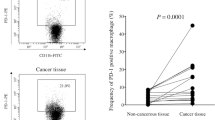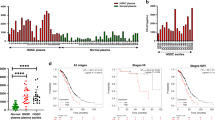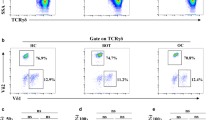Abstract
Tumor-associated macrophages (TAMs) have been characterized as a critical population of immunosuppressive cells in a variety of tumor types. PD-L1 (also termed B7-H1) has been described to exert co-inhibitory and immune regulatory functions. Here, in ovarian cancer, PD-L1 is selectively overexpressed on some TAM compared that of benign ovarian disease. When expanding the data in peripheral blood, the proportion of PD-L1+CD68+ cell among CD68+ cells and the intensity of PD-L1 staining on CD68+ cell in healthy group were similar to that observed in ovarian cyst group; instead, these two measures were significantly higher in ovarian cancer group, thereafter related to TNM stage. Interestingly, intracellular levels of IL-10, IL-6, TNF-α, and IFN-γ in PD-L1+CD68+ macrophage were higher than those in PD-L1−CD68+ macrophage, especially IL-6 expression. Based on the PD-L1 receptor PD-1 expression on tumor-infiltrating cytotoxic cells, our data supported that expression of PD-L1 on TAM promoted apoptosis of T cells via interaction with PD-1 on CD8+T cells. Taken together, these results suggested that PD-L1-expressing macrophage represents a novel suppressor cell population in ovarian cancer, which contributes immune escape of ovarian cancer.




Similar content being viewed by others
References
Solinas G, Germano G, Mantovani A, Allavena P. Tumor-associated macrophages (TAM) as major players of the cancer-related inflammation. J Leukoc Biol. 2009;86:1–9.
Mantovani A, Sica A, Allavena P, Garlanda C, Locati M. Tumor-associated macrophages and the related myeloid-derived suppressor cells as a paradigm of the diversity of macrophage activation. Hum Immunol. 2009;70:325–30.
Rai RK, Vishvakarma NK, Mohapatra TM, Singh SM. Augmented macrophage differentiation and polarization of tumor-associated macrophages towards M1 subtype in listeria-administered tumor-bearing host. J Immunother. 2012;35:544–54.
Heusinkveld M, de Vos van Steenwijk PJ, Goedemans R, Ramwadhdoebe TH, Gorter A, Welters MJ. M2 macrophages induced by prostaglandin E2 and IL-6 from cervical carcinoma are switched to activated M1 macrophages by CD4+ Th1 cells. J Immunol. 2011;187:1157–65.
Tringler B, Liu W, Corral L, Torkko KC, Enomoto T, Davidson S, et al. B7-H4 overexpression in ovarian tumors. Gynecol Oncol. 2006;100:44–52.
Chen C, Zhu YB, Shen Y, Zhu YH, Zhang XG, Huang JA. Increase of circulating B7-H4-expressing CD68+ macrophage correlated with clinical stage of lung carcinomas. J Immunother. 2012;35:354–8.
Yamazaki T, Akiba H, Iwai H, Matsuda H, Aoki M, Tanno Y, et al. Expression of programmed death 1 ligands by murine T cells and APC. J Immunol. 2002;69:5538–45.
Dong H, Chen L. B7-H1 pathway and its role in the evasion of tumor immunity. J Mol Med. 2003;81:281–7.
Curiel TJ, Wei S, Dong H, Alvarez X, Cheng P, Mottram P, et al. Blockade of B7-H1 improves myeloid dendritic cell-mediated antitumor immunity. Nat Med. 2003;9:562–7.
Liu Y, Zeng B, Zhang Z, Zhang Y, Yang R. B7-H1 on myeloid-derived suppressor cells in immune suppression by a mouse model of ovarian cancer. Clin Immunol. 2008;129:471–81.
Brahmer JR, Tykodi SS, Chow LQ, Hwu WJ, Topalian SL, Hwu P, et al. Safety and activity of anti-PD-L1 antibody in patients with advanced cancer. N Engl J Med. 2012;366:2455–65.
Topalian SL, Hodi FS, Brahmer JR, Gettinger SN, Smith DC, McDermott DF, et al. Safety, activity, and immune correlates of anti-PD-1 antibody in cancer. N Engl J Med. 2012;366:2443–54.
Yang W, Lu Y, Xu Y, Xu L, Zheng W, Wu Y, et al. Estrogen represses hepatocellular carcinoma (HCC) growth via inhibiting alternative activation of tumor-associated macrophages (TAMs). J Biol Chem. 2012;287:40140–9.
Maine CJ, Aziz NH, Chatterjee J, Hayford C, Brewig N, Whilding L, et al. Programmed death ligand-1 over-expression correlates with malignancy and contributes to immune regulation in ovarian cancer. Cancer Immunol Immunother. 2014;63:215–24.
Duraiswamy J, Freeman GJ, Coukos G. Therapeutic PD-1 pathway blockade augments with other modalities of immunotherapy T-cell function to prevent immune decline in ovarian cancer. Cancer Res. 2013;73:6900–12.
Chen J, Feng Y, Lu L, Wang H, Dai L, Li Y, et al. Interferon-γ-induced PD-L1 surface expression on human oral squamous carcinoma via PKD2 signal pathway. Immunobiology. 2012;217:385–93.
Song S, Yuan P, Wu H, Chen J, Fu J, Li P, et al. Dendritic cells with an increased PD-L1 by TGF-β induce T cell anergy for the cytotoxicity of hepatocellular carcinoma cells. Int Immunopharmacol. 2014;20(1):117–23.
Reiman JM, Kmieciak M, Manjili MH, Knutson KL. Tumor immunoediting and immunosculpting pathways to cancer progression. Semin Cancer Biol. 2007;17:275–87.
Acknowledgments
This work was supported by the “Project of National Natural Science Foundation of China (81101556),” “Research Innovation Project for University Graduate Student in Jiangsu Province (CXZZ11_0110),” “Suzhou social development project (SYS201338)” and “Jiangsu Province’s Key laboratory of Medicine (XK201135).”
Conflicts of interest
None.
Author information
Authors and Affiliations
Corresponding authors
Rights and permissions
About this article
Cite this article
Qu, QX., Huang, Q., Shen, Y. et al. The increase of circulating PD-L1-expressing CD68+ macrophage in ovarian cancer. Tumor Biol. 37, 5031–5037 (2016). https://doi.org/10.1007/s13277-015-4066-y
Received:
Accepted:
Published:
Issue Date:
DOI: https://doi.org/10.1007/s13277-015-4066-y




